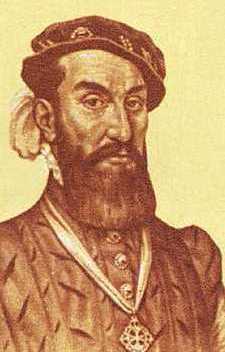The stories of the Spanish conquistadors, of men that believed themselves to be conquerors fighting and exploring for God and gold, are well known. While many of those conquistadors may have seen themselves as bringing civilization to a savage new land, there are those who would argue that this is an incorrect way to view the conquistadors. Instead, they would claim that the conquistadors were encroaching on other people’s culture and religion. One would-be conquistador ended up having a much different experience than most, an experience so different that it forced him to view the Native Americans in a new light, so much so that he eventually advocated for them. This man’s name was Alvar Nunez Cabeza de Vaca.
Cabeza de Vaca was born to a Spanish noble family in 1492. When he was young, his parents died, and he was forced to live with some other relatives. In 1521, he joined the army as an officer after distinguishing himself during military conflict in Italy. In 1527, Cabeza de Vaca embarked on an expedition to explore modern-day Florida, one led by Pánfilo de Narváez. His role in this expedition was that of treasurer for the colony.1 In addition to this, he was also ordered to let the king know of any injustices done by the Spaniards to the Native Americans. The nature of his duty did not change the way that Cabeza de Vaca viewed the Native Americans. At the beginning of the expedition, he still viewed them mainly as savages that were primarily in opposition to Spanish goals. Any respect, if any, that he gave to them was purely that of a rival in regards to their fighting ability.2 This initial attitude would end up standing in very stark contrast to the way that Cabeza de Vaca would eventually come to view them.

The beginning of the Narváez expedition was not off to a great start. Narváez imagined himself as the next Cortez and wanted to follow his example and find a city full of gold. In order to do this, Narváez had decided to pursue rumors of a city of gold, known to the natives only as “Apalachee,” instead of staying closer to the shoreline and their supplies. Narváez was hoping that he would be able to make an endless amount of wealth by conquering this civilization, but when he finally arrived on the shore, all that he and his men found was a small Native American village.3 After this accident, the expedition attempted to meet up with their ship to resupply, but the ship never arrived. It was then that Narváez decided that the crew would make their own ships and sail towards Mexico, hoping to link up with any Spanish forces in the area.4 At this point in the expedition, many of the remaining members, including Cabeza de Vaca, were convinced that their deaths were close and that their situation was dire. At one point, Narváez himself decided to abandon the other ships and survivors in favor of saving his skin. This would be the last time that Cabeza de Vaca, or anyone, would see the would-be conquistador. At the end of it all, there ended up being less than one hundred men left in the expedition, and they all eventually landed on an island that they decided to call “Malhado,” or “Misfortune.” Today, we now know this area as Galveston Island.5
It was on this island that Cabeza de Vaca first encountered the Native Americans in a new light. It was here that a group of Native Americans provided food and shelter to Cabeza de Vaca and his company. Not all of the members of the expedition took advantage of the kindness that was shown to them, however. While many were unable to trust the Native Americans, it was his willingness to trust the Native Americans that most likely saved Cabeza de Vaca’s life, as most of those who did not take their offer ended up dead. After spending the winter on the island, there were only sixteen remaining members of the expedition.6 The entire scenario was a new experience for Cabeza de Vaca, as the only way he had ever viewed the Native Americans before was as rivals. But, much to his amazement, they showed undying compassion and empathy for a group of men that they did not know. Although he originally thought that rescue was coming within a year, Cabeza de Vaca’s experience on the small island was just the beginning of what would happen to him while he lived with the Native Americans.

Cabeza de Vaca would go on to live on Malhado for about four more years while serving as a physician and trader to the tribes there. He realized that his only real chance for survival during this time was to make himself useful to the tribe. Although he had originally refused to become a healer, due to the fact that he viewed the Native American way of healing similar to idolatry, he eventually caved and started to learn their ways of healing due to necessity. He would go on to learn much about Native American culture, not because he was curious, but rather, he was forced to so in order to survive. He learned Native American languages, customs, and what items were valuable to the Native American lifestyle.7 Learning all of these skills ultimately allowed Cabeza de Vaca to survive his experience on Malhado. Over the years, Cabeza de Vaca had to get a new understanding of Native American culture as he was exposed to parts of their lives that he had never even bothered to think about before. This is also when Cabeza de Vaca most likely began embracing the different culture. When he got the opportunity, Cabeza de Vaca focused on writing many of his observations about the Native Americans, mainly on how they worked as a group and not on their individual lives. Indeed, he focused on what they did as a culture and economically above all else. This was most likely the result of the lens of mercantilism through which he often viewed the world, as it was one of the prevailing economic policies in Europe and the region that he was from.8
During his four years there, Cabeza de Vaca also met up with a few of his fellow members from the expedition that were doing similar work with other tribes, Dorantes, Estevanico, and Castillo. These three men were his main connections to his life before living in Malhado. Eventually, Cabeza de Vaca and these men decided on a gamble to leave the island in order to escape from the roles that they had been forced into during their time with the tribes. They made their escape, and, after a few days, were welcomed by a tribe on the condition that they help the tribe as healers. This predicament simply placed the men in the same situation they were in earlier. Nevertheless, they worked as healers to ensure their survival, and these men attributed any of the healing that they performed to God, as they themselves regarded any healing as a miracle.9 It was around this time that Cabeza de Vaca truly seemed to have become sympathetic to the Native Americans. Although he became genuinely worried about their well-being, he still often took offers of wealth from the tribe, and later painted himself and the other Spaniards as saviors to the Native Americans.10
Cabeza de Vaca and the others eventually found themselves well-respected by the Native Americans, and they used that fact to their advantage. In addition to accepting gifts from the tribe, they also asked the Native Americans to bring them to certain places that they wished to go. This may have started as manipulation, but after a while, Cabeza de Vaca focused on using this newfound respect to teach the Native Americans about God.11 Cabeza de Vaca and his compatriots continued to do this until they encountered a group of Spaniards near Mexico. When they finally made contact, Cabeza de Vaca quickly realized that there was a fundamental difference in the way that the Native Americans perceived him and how they perceived the other Spaniards. That is, they regard him as a man who gives back as opposed to one who takes. He also noticed that his view of the Native Americans greatly differed from that of his his fellow countrymen.12 He greeted his fellow Spaniards, and, after some negotiation, they finally decided to send him to Mexico where he rested for a while before returning to Spain.13

When Cabeza de Vaca returned to Spain, he started to write down what had happened to him during his time in the New World. In these accounts, he described his unique experiences with the Native Americans, including their treatment of him and how he worked with them in order to ensure his survival. As a result of his encounter, he was appointed the governor of a province in South America. While there, he tried to treat the Natives with respect, due to his experiences earlier in life. This policy, however, ended up upsetting many of the people he governed, and he was eventually sent back to Spain, where he lost the respect of the Spanish government. Nearing the end of his life, he ended up staying there until he died a broke man with little respect.14 Cabeza de Vaca led an amazing life, and, although it ended in a very non-climatic way, it was nevertheless one filled to the brim with moral and philosophical lessons. The story of Cabeza de Vaca is one that we should learn from: it is a great account of how cultural exchange can change the way that we see people from other cultures.
- Nan Goodman, “Mercantilism and Cultural Difference in Cabeza de Vaca’s ‘Relación,’” Early American Literature 40, no. 2 (2005): 236. ↵
- Mary Doctor, “Enriched by Otherness: The Transformational Journey of Cabeza de Vaca,” Christianity & Literature 58, no. 1 (2008): 8. ↵
- Mary Doctor, “Enriched by Otherness: The Transformational Journey of Cabeza de Vaca,” Christianity & Literature 58, no. 1 (2008): 8. ↵
- “Cabeza de Vaca, Alvar Núñez (1492?-1559?),” American Eras, 50-51. Vol. 1, Early American Civilizations and Exploration to 1600, (Detroit, MI: Gale, 1997), 51. ↵
- Carlos A. Jáuregui, “Going Native, Going Home: Ethnographic Empathy and the Artifice of Return in Cabeza de Vaca’s Relación,” Colonial Latin American Review 25, no. 2 (2016): 181. ↵
- Carlos A. Jáuregui, “Going Native, Going Home: Ethnographic Empathy and the Artifice of Return in Cabeza de Vaca’s Relación,” Colonial Latin American Review 25, no. 2 (2016): 181. ↵
- Mary Doctor, “Enriched by Otherness: The Transformational Journey of Cabeza de Vaca.” Christianity & Literature 58, no. 1 (2008): 13. ↵
- Nan Goodman, “Mercantilism and Cultural Difference in Cabeza de Vaca’s ‘Relación,’” Early American Literature 40, no. 2 (2005): 231. ↵
- Mary Doctor, “Enriched by Otherness: The Transformational Journey of Cabeza de Vaca,” Christianity & Literature 58, no. 1 (2008): 14. ↵
- Mary Doctor, “Enriched by Otherness: The Transformational Journey of Cabeza de Vaca,” Christianity & Literature 58, no. 1 (2008): 16. ↵
- Mary Doctor, “Enriched by Otherness: The Transformational Journey of Cabeza de Vaca,” Christianity & Literature 58, no. 1 (2008): 17-18. ↵
- Nan Goodman, “Mercantilism and Cultural Difference in Cabeza de Vaca’s ‘Relación,’” Early American Literature 40, no. 2 (2005): 247. ↵
- “Cabeza de Vaca, Alvar Núñez (1492?-1559?),” American Eras, 50-51. Vol. 1, Early American Civilizations and Exploration to 1600, (Detroit, MI: Gale, 1997), 51. ↵
- “Cabeza de Vaca, Alvar Núñez (1492?-1559?),” American Eras, 50-51. Vol. 1, Early American Civilizations and Exploration to 1600, (Detroit, MI: Gale, 1997), 51. ↵



97 comments
Jose Maria Gallegos Cebreros
I was born in Culiacan and raised in Culiacan. I learned in elementary school what Cabeza de Vaca did in the the area and how he got there, but never learned what else did he do. The thing that surprised me the most is that he became the governor of a province in South America, I never thought he made it that far South. I really like the map that you provide in your article of the route that Cabeza de Vaca took, it provides the reader a better understanding of what was going on with him. It is crazy that he got overturned by the people he governed and got back to Spain, and how that event affected his reputation with the Spanish government. Congrats on a great article!
Ana Diaz
I love this article! It is nice to read about how simple kindness and compassion can make a difference in how people interact. I’ve always been apprehensive when learning about history because of how rewritten to favor the wrong people it could be. For example, when learning about Spanish conquests, it’s hard to not be appalled by the treatment of Native Americans, especially when Texas and the Rio Grande Valley, where I live, used to be Native land. I am glad that Cabeza de Vaca was able to show humanity to these Native people and also learn from them instead of forcing them to assimilate into Spanish customs. Good work!
Anna Steck
I find the integration of Europeans into Native American cultures to be very fascinating. Often, they didn’t come in with great intentions of learning this new culture as it was described here. It isn’t glorified or noble, but eventually, people change. I was fascinated by what Cabeza de Vaca did with his new knowledge. He didn’t just keep it to himself, but brought it back to Spain. This is where he did step out of necessity and change his ways.
Christopher Morales
The topic you chose can teach us a lot and really put the idea of history into reflection. Cabeza de Vaca had viewed the Natives as they were described by the people he served. This completely ended up changing towards the end of the story. He tried to treat the Natives with respect during his time as a governor because he saw the commonality in their humanity. He probably saw a sense of compassion that humans have. This is something that the people he was serving did not see nor wanted to. The idea that the Natives saw Cabeza de Vaca as someone who gives and the other Spaniards as men who take has really intrigued me and made me think. There are two sides to history. I loved your topic, and you told the story of it well.
Azeneth Lozano
This was well-written article, and I learned lots of information from it. Although this is not the first time I see the name Cabeza de Vaca, it is the first time I hear how he ended his life as a “broke man with little respect” from his country. It’s crazy to see that one encounter can change the perspective of rivals from expecting the Native Americans to be brutal, they end up being very respectful and tentiativee to these Spaniards. The article was well-written and formatted, especially the last paragraph.
Marie Peterson
As someone who learned a small portion of Cabeza de Vaca’s story in Texas History in high school, this was a very informative article. This article goes deeper into the lessons he gained from his experience which are really important to history. As well, the map at the end was a great addition to the article to further understand the journey he took. Great job!
Phylisha Liscano
To start off this was an outstanding article. After reading this article, I feel like I have a better understanding of Cabeza de Vaca’s narrative, even though I just knew about him briefly before. Great work was done by the author in both sharing his narrative and highlighting a lesson. Cabeza de Vaca improved his grasp of Native American rituals and beliefs as well as his ability to respect and embrace them. Overall, this was a well-written article and you can see how much research went into it.
Barbara Ortiz
Very interesting article about Cabeza de Vaca, I enjoyed learning about him and the possibility that not all explorers and their crew were savages and barbarians toward the native populations. From reading your article, I wonder if his reception and treatment of the native people he encountered was formed from the basic need of survival as opposed to a true change to ideology of the native civilizations, ie becoming a “healer” to be useful and not executed by the tribe.
Martina Flores Guillen
It’s interesting to see what necessity does to a person’s perspective of life and how many unknown factors could affect one’s self. Learning from Cabeza De Vaca, even though one gets to expand and connect with the various traditions and lifestyles that each culture allows us to cultivate ourselves in, it will mean nothing without a genuine appeal of doing so. In the case of the Spanish “explorer,” the outcome resulted in such a perceived failure due to teh way he carried out his expedition, which is under the basis of the necessity to adapt rather than to function and absorb better or new ways to carry innovative ideas like an explorer would do.
Kristen Leary
The story of Cabeza de Vaca seems to be very different from the typical stories of explorers in the New World. Usually we hear of explorers dominating native populations with their powerful forces and disease, but here the explorer was at the mercy of the tribes he encountered. I enjoyed reading this article. I think it really shows good contrast of the cultures, specifically of Christian Spaniards in this case, and the peoples they encountered in the Americas. I thought his reluctance to be a healer because he saw it as going against religious ideals was particularly interesting.